The Progressive Era
OVERVIEW
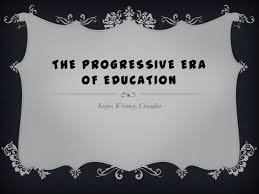 The progressive era in education was part of a larger Progressive Movement, and extended from the 1890s to the 1930s. The era was notable for a dramatic expansion in the number of schools and students served, especially in the fast-growing metropolitan cities. After 1910, smaller cities began building high schools. By 1940, 50% of young adults had earned a high school diploma.
The progressive era in education was part of a larger Progressive Movement, and extended from the 1890s to the 1930s. The era was notable for a dramatic expansion in the number of schools and students served, especially in the fast-growing metropolitan cities. After 1910, smaller cities began building high schools. By 1940, 50% of young adults had earned a high school diploma.
DEWEY AND PROGRESSIVE EDUCATION
The leading educational theorist of the era was John Dewey (1859–1952), a professor at the University of Chicago (1894–1904) and from 1904 to 1930 at 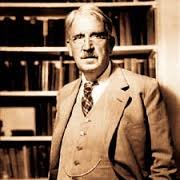 Teachers College, of Columbia University in New York City. Dewey was a leading proponent of “Progressive Education” and wrote many books and articles to promote the central role of democracy in education. He saw schools not only as a place to gain content knowledge, but also as a place to learn how to live.
Teachers College, of Columbia University in New York City. Dewey was a leading proponent of “Progressive Education” and wrote many books and articles to promote the central role of democracy in education. He saw schools not only as a place to gain content knowledge, but also as a place to learn how to live.
The purpose of education was not so much the acquisition of a predetermined set of skills, but rather the realization of the student’s full potential and the ability to use those skills for the greater good. Dewey notes that, “to prepare him for the future life means to give him command of himself. It means to train him so that he will have the full and ready use of all his capacities.” Dewey insisted that education and schooling are instrumental in creating social change and reform. He notes that “education is a regulation of the process of coming to share in the social consciousness and that the adjustment of individual activity on the basis of this social consciousness is the only  sure method of social reconstruction.” Although Dewey’s ideas were very widely discussed, they were implemented chiefly in small experimental schools attached to colleges of education. The problem was that Dewey and the other progressive theorists encountered a highly bureaucratic system of school administration that in general was not receptive to new methods.
sure method of social reconstruction.” Although Dewey’s ideas were very widely discussed, they were implemented chiefly in small experimental schools attached to colleges of education. The problem was that Dewey and the other progressive theorists encountered a highly bureaucratic system of school administration that in general was not receptive to new methods.
They argue that testing does and should focus educational resources on the most important aspects of education — imparting a pre-defined set of knowledge and skills — and that other aspects are either less important, or should be added to the testing scheme. Wikipedia
BLOOM’S TAXONOMY
Bloom’s Taxonomy is a classification of learning objectives within education proposed in 1956 by a committee of educators chaired by Benjamin Bloom who also edited the first volume of the 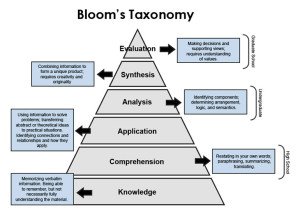 standard text, “Taxonomy of Educational Objectives: the Classification of Educational Goals” (1956). Although named after Bloom, the publication followed a series of conferences from 1949 to 1953, which were designed to improve communication between educators on the design of curricula and examinations. At this meeting, interest was expressed in a theoretical framework which could be used to facilitate communication among examiners.
standard text, “Taxonomy of Educational Objectives: the Classification of Educational Goals” (1956). Although named after Bloom, the publication followed a series of conferences from 1949 to 1953, which were designed to improve communication between educators on the design of curricula and examinations. At this meeting, interest was expressed in a theoretical framework which could be used to facilitate communication among examiners.
This group felt that such a framework could do much to promote the exchange of test materials and ideas about testing. In addition, it could be helpful in stimulating research on examining and on the relations between examining and education. After considerable discussion, there was agreement that such a theoretical framework might best be obtained through a system of classifying the goals of the educational process, since educational objectives provide the basis for building curricula and tests and represent the starting point for much of our educational research.
It refers to a classification of the different objectives that educators set for students (learning objectives). Bloom’s Taxonomy divides educational objectives into three “domains”:
Sometimes loosely described as:
- Knowing/head
- Feeling/heart
- Doing/hands
Within the domains, learning at the higher levels is dependent on having attained prerequisite knowledge and skills at lower levels. A goal of Bloom’s Taxonomy is to motivate educators to focus on all three domains, creating a more holistic form of education. A revised version of the taxonomy was created in 2000.
Bloom’s Taxonomy is considered to be a foundational and essential element within the education community as evidenced in the 1981 survey “Significant Writings that have influenced the Curriculum (1906-1981), by H.G. Shane and the 1994 yearbook of the National Society for the Study of Education.
A mythology has grown around the taxonomy, possibly due to many people learning about the taxonomy through second hand information. Bloom himself considered the Handbook, “One of the most widely cited yet least read books in American education.”
Categories in the cognitive domain of Bloom’s Taxonomy include skills in the cognitive domain revolving around “knowledge,” “comprehension,” and “critical thinking” on a particular topic. Traditional education tends to emphasize the skills in this domain, particularly the lower-order objectives. There are six levels in the taxonomy, moving through the lowest order processes to the highest.
Knowledge
Exhibits memory of previously learned materials by recalling facts, terms, basic concepts and answers including:
- Knowledge of specifics – terminology, specific facts
- Knowledge of ways and means of dealing with specifics – conventions, trends and sequences, classifications and categories, criteria, methodology
- Knowledge of the universals and abstractions in a field – principles and generalizations, theories and structures
Answering questions like: What are the health benefits of eating apples?
Comprehension
Demonstrate understanding of facts and ideas by organizing, comparing, translating, interpreting, giving descriptions, and stating the main ideas
- Translation
- Interpretation
- Extrapolation
Answering questions like: Compare the health benefits of eating apples vs. oranges.
Application
Using new knowledge to solve problems in new situations by applying acquired knowledge, facts, techniques and rules in a different way
Answering questions like: Which kinds of apples are best for baking a pie, and why?
Analysis
Examine and break information into parts by identifying motives or causes. Make inferences and find evidence to support generalizations
- Analysis of elements
- Analysis of relationships
- Analysis of organizational principles
Answering questions like: List four ways of serving foods made with apples and explain which ones have the highest health benefits. Provide references to support your statements.
Synthesis
Compile information together in a different way by combining elements in a new pattern or proposing alternative solutions
- Production of a unique communication
- Production of a plan, or proposed set of operations
- Derivation of a set of abstract relations
Answering questions like: Convert an “unhealthy” recipe for apple pie to a “healthy” recipe by replacing your choice of ingredients. Explain the health benefits of using the ingredients you chose vs. the original ones.
Evaluation
Present and defend opinions by making judgments about information, validity of ideas or quality of work based on a set of criteria
- Judgments in terms of internal evidence
- Judgments in terms of external criteria
Answering questions like: Do you feel that serving apple pie for an after school snack for children is healthy?
AFFECTIVE
Skills in the affective domain describe the way people react emotionally and their ability to feel another living thing’s pain or joy. Affective objectives typically target the awareness and growth in attitudes, emotion, and feelings. There are five levels in the affective domain moving through the lowest order processes to the highest:
Receiving
The lowest level; the student passively pays attention. Without this level no learning can occur. Receiving is about the student’s memory and recognition as well.
Responding
The student actively participates in the learning process, not only attends to a stimulus; the student also reacts in some way.
Valuing
The student attaches a value to an object, phenomenon, or piece of information.
Organizing
The student can put together different values, information, and ideas and accommodate them within his/her own schema; comparing, relating and elaborating on what has been learned.
Characterizing
The student holds a particular value or belief that now exerts influence on his/her behavior so that it becomes a characteristic.
PSYCHOMOTOR
Skills in the Psychomotor Domain describe the ability to physically manipulate a tool or instrument like a hand or a hammer. Psychomotor objectives usually focus on change and/or development in behavior and/or skills.
Bloom and his colleagues never created subcategories for skills in the psychomotor domain, but since then other educators have created their own psychomotor taxonomies. Simpson (1972) among other contributors, such as Harrow (1972) and Dave (1967), created a “Psychomotor Taxonomy” that helps to explain the behavior of typical learners or high performance athletes. The proposed levels are:
Reflex Movement
Perception as used here is “the ability to use sensory cues to guide motor activity.” This ranges from sensory stimulation, through cue selection, to translation. Examples:
- Detects non-verbal communication cues
- Estimate where a ball will land after it is thrown and then moving to the correct location to catch the ball
- Adjusts heat of stove to correct temperature by smell and taste of food
- Adjusts the height of the forks on a forklift by comparing where the forks are in relation to the pallet.
Key Words: chooses, describes, detects, differentiates, distinguishes, identifies, isolates, relates, selects.
Basic Fundamental Movement
Also set or the readiness to act. It includes mental, physical, and emotional sets. These three sets are dispositions that predetermine a person’s response to different situations (sometimes called mindsets). Examples:
- Knows and acts upon a sequence of steps in a manufacturing process
- Recognize one’s abilities and limitations
- Shows desire to learn a new process (motivation)
Key Words: begins, displays, explains, moves, proceeds, reacts, shows, states, volunteers.
NOTE: This subdivision of Psychomotor is closely related with the “Responding to phenomena” subdivision of the Affective domain.
Perceptual Guided Response
Also referred to as “Guided Response.” It is “The early stages in learning a complex skill that includes imitation and trial and error. Adequacy of performance is achieved by practicing.” Examples
- Performs a mathematical equation as demonstrated
- Follows instructions to build a model
- Responds to hand-signals of instructor while learning to operate a forklift.
Key Words: copies, traces, follows, react, reproduce, responds
Physical Activity Mechanism
Mechanism is “The intermediate stage in learning a complex skill. Learned responses have become habitual and the movements can be performed with some confidence and proficiency.” Examples:
- Use a personal computer
- Repair a leaking faucet
- Drive a car
Key Words: assembles, calibrates, constructs, dismantles, displays, fastens, fixes, grinds, heats, manipulates, measures, mends, mixes, organizes, sketches.
Skilled Movement
Also known as Complex Overt Response it is “The skillful performance of motor acts that involve complex movement patterns. Proficiency is indicated by a quick, accurate, and highly coordinated performance, requiring a minimum of energy. This category includes performing without hesitation, and automatic performance.” For example: players will often utter sounds of satisfaction or expletives as soon as they hit a tennis ball or throw a football, because they can tell by the feel of the act what the result will produce. Examples:
- Maneuvers a car into a tight parallel parking spot
- Operates a computer quickly and accurately
- Displays competence while playing the piano
Key Words: assembles, builds, calibrates, constructs, dismantles, displays, fastens, fixes, grinds, heats, manipulates, measures, mends, mixes, organizes, sketches.
NOTE: The Key Words are the same as Mechanism, but will have adverbs or adjectives that indicate that the performance is quicker, better, more accurate, etc.
Non-Discursive Communication
Also known as adaptation this is “Skills are well developed and the individual can modify movement patterns to fit special requirements.” Examples:
- Responds effectively to unexpected experiences
- Modifies instruction to meet the needs of the learners
- Perform a task with a machine that it was not originally intended to do (machine is not damaged and there is no danger in performing the new task)
Key Words: adapts, alters, changes, rearranges, reorganizes, revises, and varies.
Origination
Organization means “Creating new movement patterns to fit a particular situation or specific problem. Learning outcomes emphasize creativity based upon highly developed skills.” Examples:
- Constructs a new theory
- Develops a new and comprehensive training programming
- Creates a new gymnastic routine
Key Words: arranges, builds, combines, composes, constructs, creates, designs, initiate, makes, originates.
DEFINITION OF KNOWLEDGE
In the appendix to Handbook I, there is a definition of knowledge which serves as the apex for an alternative, summary classification of the educational goals. This is significant as the Taxonomy has been called upon significantly in other fields such as knowledge management, potentially out of context. Knowledge, as defined here, involves the recall of specifics and universals, the recall of methods and processes, or the recall of a pattern, structure, or setting.
The taxonomy is set out:
1.00 Knowledge
- 1.10 Knowledge of Specifics
- 1.11 Knowledge of Terminology
- 1.12 Knowledge of Specific Facts
- 1.20 Knowledge of Ways and Means of Dealing with Specifics
- 1.21 Knowledge of Conventions
- 1.22 Knowledge of Trends and Sequences
- 1.23 Knowledge of Classifications and Categories
- 1.24 Knowledge of Criteria
- 1.25 Knowledge of Methodology
- 1.30 Knowledge of The Universals and Abstractions in a Field
- 1.31 Knowledge of Principles and Generalizations
- 1.32 Knowledge of Theories and Structures (Bloom et al. 1956 p 201-204)
CRITICISM OF THE TAXONOMY
As Morshead pointed out on the publication of the second volume, the classification wasn’t a properly constructed taxonomy, as it lacked a systemic rationale of construction.
This was subsequently acknowledged in the discussion of the original taxonomy by Krathwohl et al. in the revision of the taxonomy and the taxonomy reestablished on more systematic lines. It is generally considered that the role the taxonomy played in systematizing a field was more important than any perceived lack of rigor in its construction.
Some critiques of Bloom’s Taxonomy’s (cognitive domain) admit the existence of these six categories, but question the existence of a sequential, hierarchical link. Also the revised edition of Bloom’s taxonomy has moved Synthesis in higher order than Evaluation. Some consider the three lowest levels as hierarchically ordered, but the three higher levels as parallel. Others say that it is sometimes better to move to Application before introducing concepts. This thinking would seem to relate to the method of problem-based learning. Wikipedia
BLOOM’S REVISED TAXONOMY
Taxonomy of Cognitive Objectives was developed by Benjamin Bloom in the 1950s. It is a means of expressing qualitatively different kinds of thinking. It was adapted for classroom use as a planning tool and continues to be one of the most universally applied models. It provides a way to organize thinking skills into six levels, from the most basic to the more complex levels of thinking.
In the 1990s- Loren Anderson (former student of Bloom) revisited the taxonomy. As a result, a number of changes were made. The new terms for rigorous hieratical thinking in descending order are:
- Creating/ Synthesis
- Evaluating/ Evaluation
- Analyzing/ Analysis
- Applying/ Application
- Understanding/ Comprehension
- Remembering/ Knowledge
Change in Terms
The names of six major categories were changed from noun to verb forms. As the taxonomy reflects different forms of thinking and thinking is an active process verbs were used rather than nouns. The subcategories of the six major categories were also replaced by verbs and some subcategories were reorganized. The knowledge category was renamed. Knowledge is an outcome or product of thinking not a form of thinking per se.
Consequently, the word knowledge was inappropriate to describe a category of thinking and was replaced with the word remembering. Comprehension and synthesis were retitled to understanding and creating respectively, in order to better reflect the nature of the thinking defined in each category.
Bloom’s Revised Taxonomy generates new ideas, products, or ways of viewing things; designing, constructing, planning, producing, inventing, evaluating and justifying a decision or course of action; checking, hypothesizing, critiquing, experimenting, judging and breaking information into parts to explore understandings and relationships; comparing, organizing, deconstructing, interrogating, finding and using information in other familiar situations; implementing, carrying out, using, executing and explaining ideas or concepts; interpreting, summarizing, paraphrasing, classifying, explaining; recalling information and recognizing; listing, describing, retrieving, naming, and finding.
Retrieved from: http://www.kurwongbss.qld.edu.au/thinking/Bloom/blooms.htm

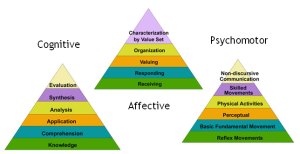
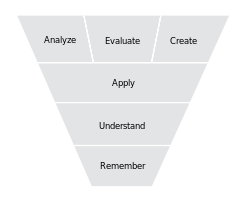
Recent Comments